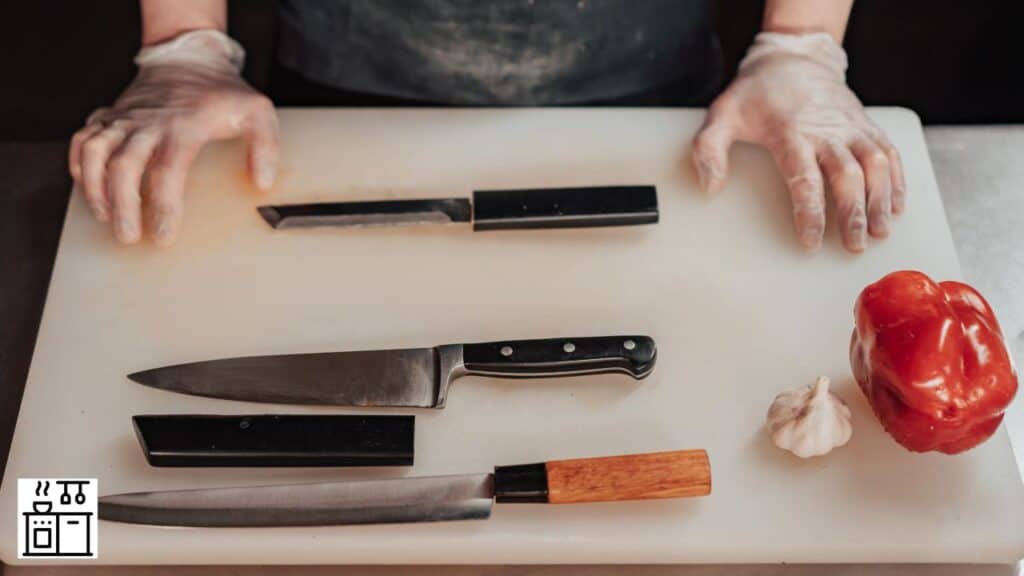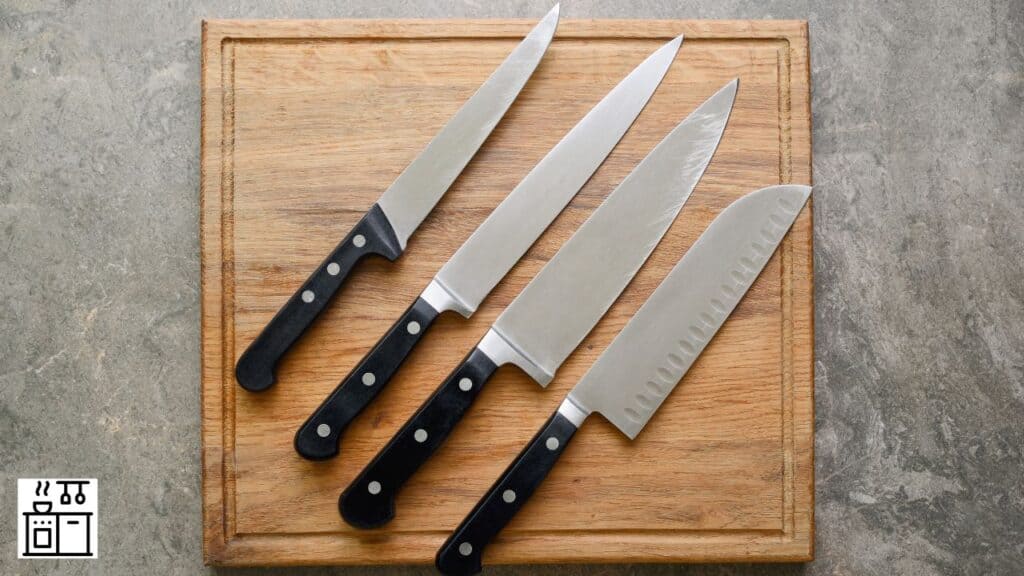Knives are cutting instruments with two main parts, a blade, and a handle. They can make a world of difference when it comes to food preparation.
Different types of knives can streamline cooking and make the process more efficient and enjoyable.
Let’s look at how to use knives, handle them properly, and maintain them in the best ways possible.
- 1. Hold the Knife Properly
- 2. Secure the Cutting Surface
- 3. Learn to Chop Properly
- 4. Be Careful About Using Your Fingers to Guide the Food
- 5. Create a Flat Surface on The Ingredient
- 6. Clean the Knife Between Uses
- 7. Don't Soak a Knife for Too Long
- 8. Always Work with A Sharp Blade
- 9. Use the Appropriate Knife for Each Cutting Method
- 10. Put the Knife Away Safely After Use
1. Hold the Knife Properly
A good grip will improve your speed and help you make clean cuts using a knife. Always hold the knife in your dominant hand.
We recommend the pinch grip to properly hold it.
In this case, your index finger will be on the outside of the blade, and the other three fingers will be on the top of the handle, just at the blade, parallel to your body.
This method gives you optimum control over the knife, and you can keep it going where you want it.
2. Secure the Cutting Surface
A slippery cutting surface is an invitation for accidents. To avoid injury, make sure that you secure the chopping board.
The best way is to place a damp washcloth below the board. It will prevent the chopping board from moving away.
Also, ensure that the board surface is dry.
3. Learn to Chop Properly
There are different techniques to chop food. But each cook has his own comfortable way to slice food with a knife.
If you are a beginner, you can attempt either the tip-fulcrum method or the wrist-fulcrum method.
In the first method, the tip of the knife will act as a fulcrum and never leave the surface of the chopping board.
You will only raise the blunt end up and down, firmly pushing the blade into the ingredient.
In the second method, the back side of the blade will never leave the cutting surface.
The knife will rise and fall across the ingredient from the top part only.
4. Be Careful About Using Your Fingers to Guide the Food
The correct chopping method involves using your curled fingers as a guide to move the knife. There is a safe distance to place your hand.
Avoid getting too close or too far from the blade. Getting too close to the blade increases your risk of getting cut when the knife moves.
Meanwhile, moving too far from the blade will affect the way the knife balances in your hand.
It takes time and practice to master this skill. But even if you are an expert, exercise caution while using knives since even a slight mistake can cause a big injury.
5. Create a Flat Surface on The Ingredient
When using a knife to cut ingredients, it should sit flat on the surface to avoid slipping and accidents.
It’s extremely important when chopping round ingredients, like tomatoes and carrots.
To secure the ingredient, slice off a portion to create a flat surface.
Rest this flat surface against the chopping board. Always remember to cut with the flat side down to avoid accidents.
6. Clean the Knife Between Uses

A knife has two parts—the handle and the blade. It’s important to keep both these areas clean.
A dirty knife blade can cause cross-contamination of ingredients.
It’s also equally important to keep the knife handle clean. An oily or greasy handle can slip in your hand and lead to an accident.
So, avoid using a knife if the handle is greasy or oily. Always wash it and dry it thoroughly to ensure a secure grip.
7. Don’t Soak a Knife for Too Long
When you cut through sticky or greasy ingredients, your knife blade may be difficult to clean.
Even if you use warm soapy water, all the sticky stuff may not come off.
In this case, you may have to soak the knife for some time. But avoid soaking it for too long.
Leaving the knife in water for too long will dull the blade. Put it in for a fixed duration and immediately scrub off the residue and dry it well.
Similarly, avoid putting the knife in the dishwasher.
8. Always Work with A Sharp Blade
All knife blades become dull over time. The more you use the metal, the faster it becomes blunt. Using a blunt knife is a safety hazard.
You will be forced to apply more force than necessary to chop the ingredients.
There is also an added risk of the blade slipping when you apply too much force.
Sharpen your blade immediately if you feel it has become blunt.
Depending on the type of knife, you may be able to sharpen it at home or may have to get it done by a professional.
You can sharpen most knives at home using a knife steel or whetstone.
Hold the knife at an angle and run it along the steel. It will get rid of the nicks and burrs in the blade and create a single undulating surface.
But certain knives, like serrated knives, can’t be sharpened in this manner.
Similarly, the blades of certain types of Japanese knives, like Shun knives, become dull over time because of the strands becoming misshapen.
The sharpening process is slightly different for these knives.
You must use a honing steel to re-align the misshapen strands into position.
This is different from the traditional sharpening method. It takes less time and doesn’t remove any material from the blade.
9. Use the Appropriate Knife for Each Cutting Method
Different types of knives are designed for differing cutting methods.
Choosing the right type of knife will reduce your effort while delivering better results.
Here are the ideal knife choices for different needs:
- Chef’s knife is best for chopping, mincing, and dicing. It can cut fruits and vegetables into small slices or squares.
- A paring knife is good for peeling and slicing fruits and vegetables. The thin and long blade makes it easy to cut under the skin of fruits and vegetables and easily dislodge it.
- Bread knives have serrated edges that make it easy to cut through a loaf of bread. You can also use it to cut cakes or roasted meat.
While these are the basic knives every kitchen should have, there are other knives too.
You may like to include them in your toolkit depending on the type of dishes and recipes you frequently prepare.
10. Put the Knife Away Safely After Use
Once you finish using your knife, promptly clean it and put it away.
Never leave it unattended or accessible to children since it can end up causing an unfortunate accident.
Always place it in a secure place where it’s out of harm’s way.
If your knife needs proper cleaning, don’t place it in a sink with soapy water where it’s not clearly seen.
Someone can accidentally cut their hand while fishing around for it in the water.
Also, place the knife with the blade facing downward while soaking to eliminate any chance of injury.

